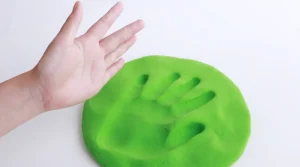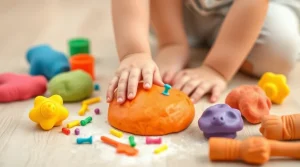
What Is the Science Behind Playdough? Uncover the Chemistry
What makes playdough soft, stretchy, and long-lasting? Explore the chemistry and physics behind this classic sensory material in a fun way.
#1 Toys Manufacturer in China. WhatsApp: +86 180-0088-4063. Email: [email protected]
#1 Toys Manufacturer in China. WhatsApp: +86 180-0088-4063. Email: [email protected]

Both playdough and slime are widely used in sensory play, which helps children develop fine motor skills, creativity, and problem-solving abilities.
The question many people ask is: Can you mix playdough and slime? This may sound like a fun experiment, but the real question is, what happens when you combine these two materials? Do they create a new texture, or will they turn into a gooey mess?
Mixing playdough and slime seems like an exciting experiment, but it’s important to understand the scientific reaction behind it. Both materials have different textures and chemical properties, and combining them leads to unique interactions.
The difference between playdough and slime lies in their molecular structure.
When you mix these two substances, the playdough often loses its stiffness. The slime’s gooey texture can soften the playdough, and depending on the ratio, you may end up with a squishy, sticky substance.
The polymer chains in slime might break apart or interact with the ingredients in the playdough, affecting its consistency.
The dense, firm texture of playdough clashes with the stretchy, gooey texture of slime. As the slime is more fluid, it may soften the playdough over time, causing it to become less structured.
You might notice that the slime becomes thicker or more rubbery as the playdough gets incorporated, while the playdough may lose its original shape. The two textures blend, but don’t always form a completely uniform consistency. Instead, the result may look like a mix of the two.
When mixed, the texture and consistency of the materials change. Playdough may absorb some of the slime’s moisture, becoming a bit more elastic, while slime might become less slimy, losing some of its stretchiness and becoming more solid.
The mixture can be thick and sticky, or it may be gooey and hard to control, depending on the ratio of slime to playdough.
If too much playdough is used, the mixture may lose its stretch and become too firm, while too much slime could make the mix overly gooey.
Now that we know the scientific reactions and interactions, what can you expect when mixing playdough and slime? Will it form a new material, or will they stay separate?
The outcome is a blend of both materials, but not necessarily a new substance. While you may end up with something that’s a little more elastic or squishy, it won’t become a stable, uniform material like some other combinations.
The playdough and slime won’t perfectly meld into a single, new substance but will instead form a texture that’s somewhere between the two. You’ll have something that’s fun to squish and stretch, but it might not hold its form or behave in the same way either playdough or slime would on its own.
Understanding the differences between playdough and slime is essential when thinking about mixing them. While both are popular in sensory play, their properties are quite distinct, leading to different textures, behaviors, and outcomes when combined.
Playdough is known for its firmness and flexibility. It has a dough-like consistency that is easy to mold, shape, and hold.
One of the primary characteristics of playdough is its malleability; it can be rolled, pinched, and formed into various shapes without losing its structure. It maintains its form under normal conditions and doesn’t flow or stretch.
Playdough’s firmness gives it a solid and stable texture, allowing for precise sculpting and creative play. Its flexibility also means it can be shaped repeatedly, though it tends to dry out over time, losing its softness.
Slime is very different from playdough in both texture and behavior. The key characteristics of slime are its stretchiness, stickiness, and flow.
Unlike playdough, slime is a non-Newtonian fluid, meaning its viscosity changes depending on the pressure applied. It can stretch to incredible lengths without breaking, and when pulled apart, it flows or drips, making it incredibly fun to play with.
Slime tends to be stickier than playdough, often leaving traces on surfaces or hands. It can also be a bit messy, depending on its thickness and composition. Slime’s stretchy nature gives it a more fluid, elastic quality, which contrasts sharply with playdough’s dense, stable consistency.
The differences in the chemical properties and textures of playdough and slime are key when considering how they behave when mixed.
When mixed, the contrasting textures cause the slime to soften the playdough. The solid, firm playdough loses some of its structure and becomes more elastic, while the slime may lose some of its stickiness and flow.
This is because the slime’s moisture interacts with the playdough’s ingredients, breaking down the dough’s firmness and affecting its malleability.
The end result of mixing the two materials will depend on the proportion of slime and playdough used, but the differences in texture and chemical properties are what drive the final outcome.
When you mix playdough and slime, the result is a curious blend of two materials with very different properties. Whether the outcome is a new texture or just a messy combination depends on various factors, including the proportions of each ingredient and how they interact.
>> How Is Playdough Made? Exploring the Key Ingredients
Mixing playdough and slime doesn’t always result in a completely new texture, but rather a unique combination of both. The slime tends to soften the playdough, making it stretchier and more pliable, while the playdough may absorb some of the moisture from the slime, affecting its flow and stickiness.
The final result can be a hybrid texture that’s somewhere between the firm, moldable consistency of playdough and the stretchy, gooey nature of slime.
However, it’s not always a smooth transition. Depending on the ratio of playdough to slime, the mixture could turn out to be more of a gooey mess or an oddly sticky substance that doesn’t quite mimic either material’s original form.
If the result is not quite what you expected, don’t worry—there are ways to salvage the mixture. If the slime is too runny or the playdough too stiff, you can adjust the consistency by adding more of either ingredient.
For a runny mixture, adding more playdough can help thicken it, while adding more slime can loosen up a doughy consistency. If the mixture becomes too sticky, you can sprinkle in a little cornstarch or flour to absorb excess moisture and restore a more manageable texture.
Another approach to salvage the mixture is to knead it thoroughly. Sometimes, the slime and playdough need a bit more time to combine properly.
As you knead, you can feel how the materials are reacting and make adjustments as needed. If the mixture has become too dry or crumbly, adding a small amount of water or a bit more slime can help restore its flexibility and stretch.
>> Slime Activator 101: What Is It and How Does It Work?
Combining playdough and slime can lead to unexpected and engaging playtime experiences. Though they differ in texture and behavior, using them side by side opens up new possibilities for creative exploration.
When kids squish slime into playdough or stretch playdough through slime, they experience a contrast in resistance, moisture, and texture. This hands-on sensory input helps them become more aware of how materials feel and behave. They may notice how the stickiness of slime meets the firmness of dough—or how slime softens as it blends. No two mixes feel the same, which keeps exploration fresh.
You can also add safe sensory elements like beads, soft foam pieces, or even scents. For example, one child might enjoy kneading grape-scented slime into vanilla-scented dough, turning the experience into a multi-sensory activity.
With a bit of imagination, kids can create “alien landscapes,” textured monsters, or marbled sculptures using both materials. They can flatten playdough into terrain and pour slime over it as lava or rivers. Alternatively, mix just enough slime into dough to create squishy balls or stretchable coils for creature limbs.
One popular project: make a “slime sandwich” by layering thin sheets of playdough and slime. It’s messy—but fun. Letting kids invent their own projects encourages open-ended play and experimentation, rather than rigid step-by-step tasks.
Mashing, twisting, squeezing, and rolling a mixture of slime and playdough supports fine motor development. These actions strengthen small hand muscles, which are important for writing, tying shoes, and using tools. For example, asking a child to pinch and pull slime off a dough ball works hand-eye coordination in a playful, low-pressure way.
You can also set challenges—like rolling slime-covered dough into a ball without it falling apart. These tasks aren’t just fun; they help kids build control, patience, and spatial awareness. And since no two materials behave the same, switching between them keeps their hands and minds alert.
>> Sensory Play with Playdough: Benefits and Ideas
Mixing playdough and slime might seem odd at first, but many kids are naturally curious and try it anyway. Some combinations can lead to creative fun, while others may create a sticky mess. So—is it worth it?
Combining playdough and slime can offer a unique sensory experience. Kids feel two very different textures working together—one stretchy and gooey, the other firm and moldable. This contrast encourages curiosity and experimentation.
It also gives kids a chance to think like mini scientists. They notice changes in texture, color, and consistency as they mix. Some even try to separate the two afterward—an unexpected challenge in problem-solving and fine motor control.
Mixing materials may also keep kids engaged longer. When the novelty of one texture fades, the other brings it back to life. For children who love hands-on play, this hybrid mix can be a fun way to stay focused and creative.
However, there are real challenges. One major issue is cleanup. The sticky parts of slime can cling to playdough, making it hard to separate or reuse either material. You may end up with a grayish blob that’s too gooey to shape and too thick to stretch.
Texture isn’t the only concern. If the slime contains borax or certain glues, it may dry out the dough faster. And if your playdough is homemade with salt, mixing it into slime may break down its structure, turning the mix lumpy or flaky.
Finally, some kids may dislike the unexpected mess or feel frustrated when their favorite dough or slime gets “ruined.” Supervision helps, especially for younger kids, and it’s a good idea to set clear expectations: this is an experiment, not a guaranteed success.
Mixing playdough and slime blends science with hands-on fun. While textures may clash or create surprises, it’s a safe, curious way for kids to explore materials and creativity. Just be ready for mess—and a little magic—in every experiment.
Yes. Mixing the two can shorten the lifespan of both materials. Playdough can dry out faster, and slime may lose its stretch due to the added starch or flour in playdough.
It’s not recommended. Edible playdough is made from food-based ingredients, while slime often contains glue or borax. Mixing them could lead to unsafe or moldy results.
Over time, the textures will continue to break down. The mix may become sticky, lumpy, or even moldy due to trapped moisture and incompatible ingredients.
Yes. It offers a fun way to observe reactions between materials. Kids can explore viscosity, absorption, and how ingredients like starch and polymers behave together.
Definitely. Colors can blend quickly, especially if the slime is sticky. The result is often a dull or muddy shade, depending on the original colors used.
More Related...

What makes playdough soft, stretchy, and long-lasting? Explore the chemistry and physics behind this classic sensory material in a fun way.

Maximize your playdough and air dry clay’s freshness with easy storage tips and tricks that keep them soft and ready to use.

Playdough is a good craft toy, especially suitable for children aged 3+ to develop hands-on skills. Now let’s make a cute caterpillar craft.

Playdough or traditional clay? Learn which one offers the best opportunities for creative play and developmental growth for your child!

Our team will answer your inquiries within 48 hours.
Copyright © 2025 GuangDong AKIA Technology Co,. Ltd. All Rights Reserved